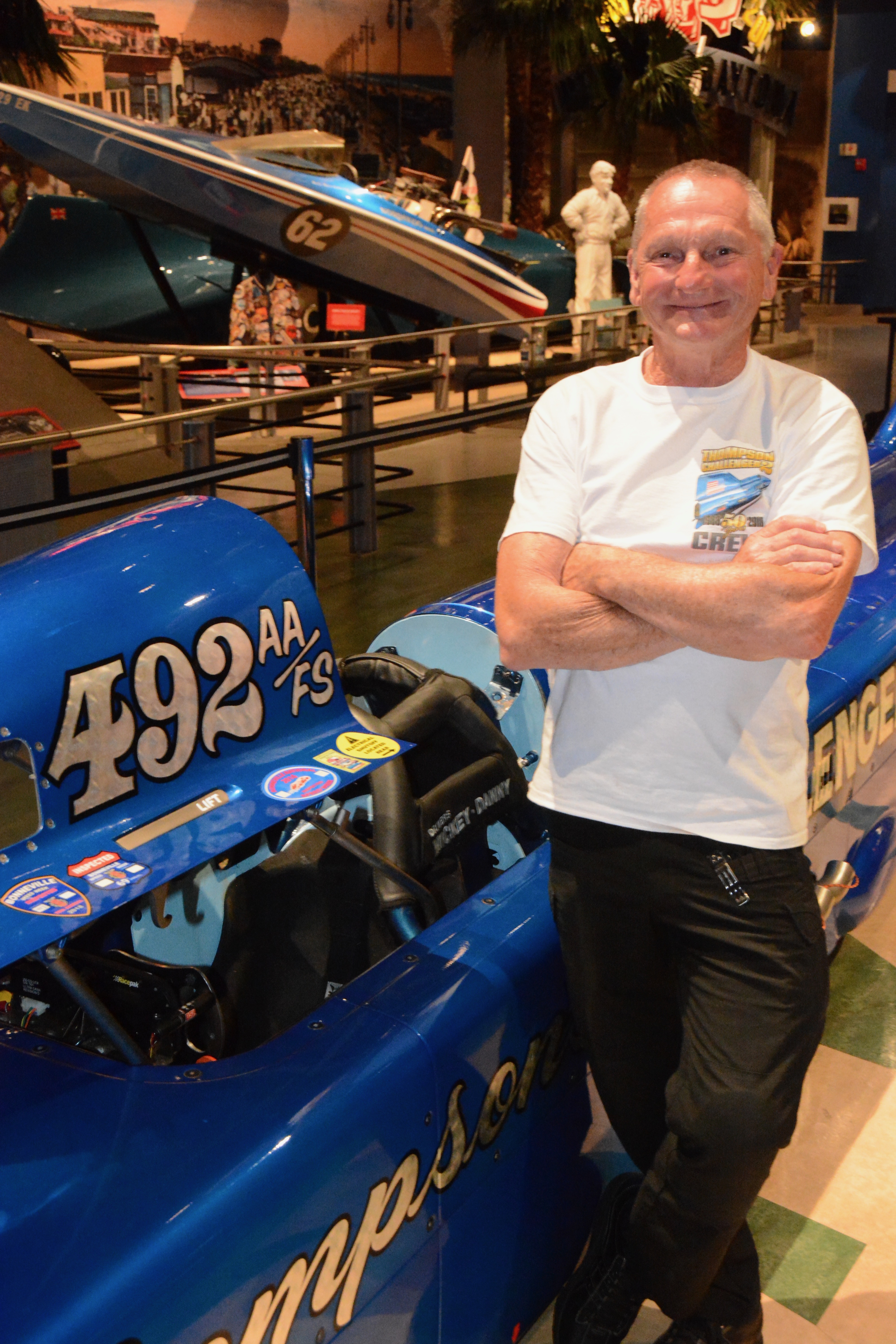Quick! What’s 34 inches wide, 37 inches tall, 32 feet long, and goes 448 miles per hour?
The answer is Challenger 2, the world-record car built and driven by Colorado racing veteran Danny Thompson.
The car, is on display at the Motorsports Hall Of Fame of America Museum adjacent to the Daytona International Speedway in Florida, and by the time you’re reading this should have been joined there by its predecessor, Challenger 1.

Thompson, the only son of racing legend Mickey Thompson, worked for eight years to rebuild the car that his father left to him, a twin-engined, all-wheel-drive streamliner his father had driven to 363 mph before the project was abandoned back in 1968. The car sat in a trailer for 42 years before Danny decided to go for the record in 2010“One of the things that most people don’t realize about my dad was that he was never afraid to fail,” Danny notes.
After all that time, Challenger 2, originally built with Ford’s help at Kar Kraft in Dearborn, Michigan, had to be completely disassembled, rethought, re-engineered and rebuilt with all the latest available technology and safety equipment around two new engines.
It took eight years, every ounce of Danny’s creativity, determination and every dime he had, but, in August of last year, 50 years after his dad’s last attempt, Thompson took the finished car to the Bonneville Salt Flats in Utah.

He made several warmup runs, and then two runs over the five-mile course, averaging 448.757 mph to become the fastest piston-engined car of all time (there are separate records for rocket cars, jet cars, turbine cars, and supercharged piston-engined cars, but Thompson’s is a “real” car.
It uses two naturally aspirated 500 cubic-inch Chrysler Hemi-style drag racing engines and nitromethane fuel to make more than 6,000 horsepower. The engines use almost all of the 50 gallons of fuel onboard during a run, which means the 5,200-pound car is 500 pounds lighter at the end of a run than at the start, which helps it achieve its top speed.
One of the things that most people don’t realize about my dad was that he was never afraid to fail.”
Danny had already eclipsed his famous father’s 406.6 mph record run by a single tenth of a mile per hour during a previous outing, but the 448 mph run may have put the record out of sight. Mickey’s first land speed record car, Challenger 1, was a much bigger car, and used four Ford 427 engines to go 406 mph.

Mickey left a huge legacy of innovation and racing successes. He started as a drag racer in Los Angeles and is credited with the invention of the slingshot dragster. He designed and built his own cylinder heads. He took over the management of the Lions drag strip in Long Beach, built Challenger 1 in 1960 and became the first American to go over 400 mph in it.
He raced a team of Super Stock Pontiacs for the factory in 1962, and then started designing, building and racing cars that same year for the Indianapolis 500, using a radical rear-engined design and employing legendary driver Dan Gurney.
He raced all kinds of innovative cars at Indy through 1968. He then switched to drag racing with Ford funny cars and was successful immediately with Danny Ongais driving. He started his own Mickey Thompson high-performance tire company. To this day, Mickey Thompson holds more speed records than any other man in history. Big shoes.
Another big switch came in 1973 when Mickey started Southern California Off-Road Enthusiasts or SCORE for professional off-road racing in Mexico, California, Arizona, and Nevada, and he later created spectator-oriented stadium off-road racing.
“One of the things that most people don’t realize about my dad was that he was never afraid to fail,” Danny notes.
During all that time, Mickey forbid Danny to race in any form, shape or manner because of the danger. So Danny became a ski bum and ran construction equipment. He raced anyway, winning 18 straight motocross events, switching to cars in Formula Atlantic, SuperVee, and sprint cars before obtaining a factory contract driving for Chevrolet.
Ultimately, he was allowed to co-drive and act as riding mechanic in off-road events with his dad. Danny became a master welder, fabricator and artist in metal, built Indy cars for Ongais and Gurney, and, after his father’s death, he decided to sell off a number of his father’s race cars and put the money into rebuilding Challenger 2. That effort was supplemented by hundreds of individual contributions, including a single dollar sent in by a 6-year-old boy.
“It was eight years, seven days a week working on the car, and even longer than that trying to get sponsorship,” Danny says. “We sacrificed everything we had to do it. We don’t have any money, but that’s okay, because that’s what we wanted to do.”

And, what about the future?
“I’d desperately like to build another car. I’d like to go 500.”





